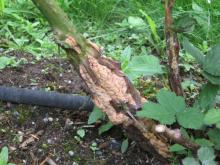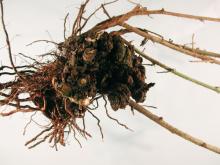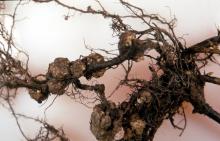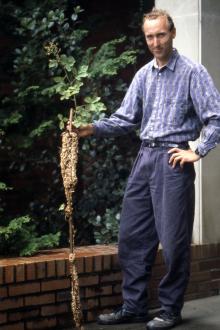See:
Blackberry Cultivar Susceptibility
Cause Agrobacterium tumefaciens and A. rubi are the two bacterial pathogens associated with crown gall on blackberry. The bacteria may come into a planting with infected plants or persist in soil as a result of previously infected plants. Once present in a field they can survive for years in the soil as saprophytes. They are spread by splashing rain, irrigation water, pruning tools, wind, insects, farm machinery, and on contaminated propagation material (cuttings, grafting stock). Caneberry host plants include blackberries, black-, red-, purple-, or yellow-raspberries, 'Boysenberry', 'Loganberry', and 'Youngberry'. The cultivar Chester is very susceptible.
Infection is through cane or root crown injuries. Injuries such as lateral root formation, leaf scars, or winter injury can occur naturally. Mechanical injuries, such as those from pruning, training, and harvesting, favor the disease. Cane gall can occur from splits in the cane from bending and training the cane. After the bacterium enters a wound, a small piece of its DNA is transferred into the plant's DNA. The foreign DNA transforms normal plant cells in the wounded area into tumor cells. Once transformed, tumor cells proliferate automatically. The result is a gall, a disorganized mass of hyperplastic and hypertrophic tissue.
The critical time to protect against crown gall is the first year after planting. Experimentally initiated infections during the first growing season after planting resulted in severe weakening or death of the plants.
Symptoms Crown gall appears on fruiting canes as small rough ridges or elongated overgrowths of granular gall tissue. Galls frequently cause canes to split open. Crown gall infections also may develop as irregular warty galls at the canes' base or on roots. Small galls are easily confused with tissue overgrowths caused by excessive callus formation at wound sites, particularly in the process of rooting stem cuttings. Symptoms may not develop for over a year if infection occurs when temperatures are below 59°F. Although galls blacken and may die over the winter, new galls may erupt the following spring near the old galls.
Cultural control
- Use certified nursery stock from fields where gall has not been found.
- Inspect planting stock and do not plant new canes that show galls on canes, crowns, or roots.
- If only a few plants are infected, remove them from the field and destroy them.
- Establish new plantings on uninfested land wherever possible.
- Prune canes only during dry weather and frequently disinfect pruning equipment.
- Use care when harvesting and training, so not to injure canes.
- Preplant soil solarization has been effective for cherry nursery stock in western Oregon and may have some value for home or organic production. Place clear plastic (preferably anti-condensation film) directly on smooth, rototilled ground, which has been irrigated to field capacity, and then allowed to drain for 1-2 days. Bury the edges of the plastic to trap the heat. Solarize for 4-6 weeks (or longer) during the hottest part of the summer, beginning in early- to mid-July.
Biological control Dipping the roots and crown area of blackberry plants in commercial preparations of the bacterium A. radiobacter K84 or strain K1026 before planting provided good protection for at least the first year, thus helping the plants to become well established. Follow manufacturer's directions. To be effective it must be applied a few hours after wounding. Change solution frequently, because if a set of plants contaminated with other pathogens is dipped, then all succeeding plants dipped into the same container/solution will become contaminated.
- Galltrol-A (Agrobacterium radiobacter K84) can be used on nonbearing plants. Not registered in Idaho. 12-hr reentry. O
- NOGALL at 8.8 oz/2.5 gal unchlorinated water per 2,500 nonbearing plants. Apply within 2 hours of lifting and/or damaging plants. Do not use with any pesticides or fertilizers. 4-hr reentry. O
References Martin, R.R., Ellis, M.A., Williamson, B., and Williams, R.N. 2017. Compendium of Raspberry and Blackberry Diseases and Pests. 2nd edition. St. Paul, MN: APS Press.
Garrett, C.M. 1978. Crown gall of blackberry: field spread and susceptibility to disease. Plant Pathology 27:182-186.






